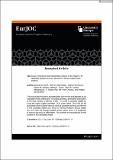Files in this item
Scope, limitations and mechanistic analysis of the HyperBTM-catalyzed acylative kinetic resolution of tertiary heterocyclic alcohols
Item metadata
| dc.contributor.author | Smith, Samuel | |
| dc.contributor.author | Greenhalgh, Mark D. | |
| dc.contributor.author | Feoktistova, Taisiia | |
| dc.contributor.author | Walden, Daniel M. | |
| dc.contributor.author | Taylor, James E. | |
| dc.contributor.author | Cordes, David B. | |
| dc.contributor.author | Slawin, Alexandra M. Z. | |
| dc.contributor.author | Cheong, Paul Ha-Yeon | |
| dc.contributor.author | Smith, Andrew D. | |
| dc.date.accessioned | 2022-11-11T00:43:24Z | |
| dc.date.available | 2022-11-11T00:43:24Z | |
| dc.date.issued | 2022-01-11 | |
| dc.identifier | 276154021 | |
| dc.identifier | 0042408d-7c39-4310-b3a7-d60d1bdb2668 | |
| dc.identifier | 85118824423 | |
| dc.identifier | 000717013700001 | |
| dc.identifier.citation | Smith , S , Greenhalgh , M D , Feoktistova , T , Walden , D M , Taylor , J E , Cordes , D B , Slawin , A M Z , Cheong , P H-Y & Smith , A D 2022 , ' Scope, limitations and mechanistic analysis of the HyperBTM-catalyzed acylative kinetic resolution of tertiary heterocyclic alcohols ' , European Journal of Organic Chemistry , pp. 30-43 . https://doi.org/10.1002/ejoc.202101111 | en |
| dc.identifier.issn | 1434-193X | |
| dc.identifier.other | ORCID: /0000-0002-2104-7313/work/103510852 | |
| dc.identifier.other | ORCID: /0000-0002-9527-6418/work/103510915 | |
| dc.identifier.other | ORCID: /0000-0002-5366-9168/work/103510944 | |
| dc.identifier.uri | https://hdl.handle.net/10023/26371 | |
| dc.description | The research leading to these results has received funding from the ERC under the European Union's Seventh Framework Programme (FP7/2007-2013)/E.R.C. grant agreement n° 279850. A.D.S. thanks the Royal Society for a Wolfson Research Merit Award. We thank the EPSRC UK National Mass Spectrometry Facility at Swansea University. P.H.-Y.C. is the Bert and Emelyn Christensen Professor and gratefully acknowledges financial support from the Stone Family of OSU. Financial support from the National Science Foundation (NSF) (CHE-1352663) is acknowledged. D.M.W. acknowledges the Bruce Graham and Johnson Fellowships of OSU. D.M.W. and P.H.-Y.C. acknowledge computing infrastructure in part provided by the NSF Phase-2 CCI, Center for Sustainable Materials Chemistry (CHE-1102637). | en |
| dc.description.abstract | The full scope and limitations of the catalytic acylative kinetic resolution of a range of tertiary heterocyclic alcohols (78 examples, s up to >200) is reported under operationally-simple conditions, using low loadings of a commercially available Lewis basic isothiourea catalyst, HyperBTM (generally 1 mol %). The protocol is highly effective for the kinetic resolution of 3-substituted 3-hydroxyoxindole and α-substituted α-hydroxylactam derivatives bearing up to three potential recognition motifs at the stereogenic tertiary carbinol center. The full power of this methodology has been showcased through the synthesis of highly enantioenriched biologically-active target compounds in both enantiomeric forms. To provide further insight into the reaction mechanism, a detailed kinetic analysis of this Lewis base-catalyzed acylation of tertiary alcohols is reported using the variable time normalization analysis (VTNA) method. | |
| dc.format.extent | 14 | |
| dc.format.extent | 3739983 | |
| dc.language.iso | eng | |
| dc.relation.ispartof | European Journal of Organic Chemistry | en |
| dc.subject | Kinetic resolution | en |
| dc.subject | Enantioselectivity | en |
| dc.subject | Acyl transfer | en |
| dc.subject | Organocatalysis | en |
| dc.subject | Tertiary alcohol | en |
| dc.subject | QD Chemistry | en |
| dc.subject | DAS | en |
| dc.subject | MCC | en |
| dc.subject.lcc | QD | en |
| dc.title | Scope, limitations and mechanistic analysis of the HyperBTM-catalyzed acylative kinetic resolution of tertiary heterocyclic alcohols | en |
| dc.type | Journal article | en |
| dc.contributor.sponsor | European Commission | en |
| dc.contributor.sponsor | The Royal Society | en |
| dc.contributor.institution | University of St Andrews. School of Chemistry | en |
| dc.contributor.institution | University of St Andrews. EaSTCHEM | en |
| dc.identifier.doi | 10.1002/ejoc.202101111 | |
| dc.description.status | Peer reviewed | en |
| dc.date.embargoedUntil | 2022-11-11 | |
| dc.identifier.grantnumber | N/A | en |
| dc.identifier.grantnumber | WM140071 | en |
This item appears in the following Collection(s)
Items in the St Andrews Research Repository are protected by copyright, with all rights reserved, unless otherwise indicated.

